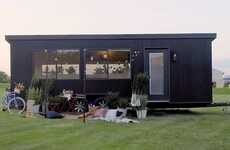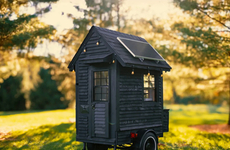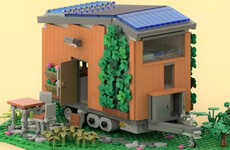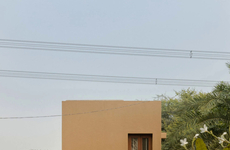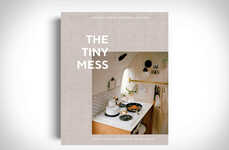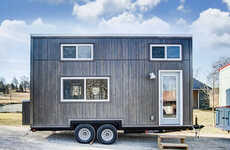
Small Home Movement
Jenn Viane — May 8, 2012 — Social Good
References: tiny-themovie & facebook
Tiny: A Story About Small Living documents the construction of Merete Mueller and Christopher Smith's 130-square-foot home in Colorado and highlights other small homes and those who love them. What makes a house a home? Is living simply the key to happiness? Can small living enthusiasts save our planet? Merete shares why she and Christopher chose small living.
Four Questions with Merete Mueller
1. Why did you get involved in making Tiny: A Story About Small Living and the small home movement?
At first, we didn't even realize that there was a movement behind small homes. Our story began when my boyfriend, Christopher, impulsively bought a plot of land in mountains of Colorado, as part of fulfilling a lifelong dream to have a small cabin that he'd built himself. Once we started doing research, we realized that most counties in the U.S. have minimum house size standards as part of their building codes. In Park County Colorado, where the land is, we would have to build a house that was at least 600 square feet. That was a bit too big for us -- we didn't have that kind of budget or enough building skills for a full-sized house -- so that's when we decided to go tiny. Because our 130-square-foot house is built on a flat-bed trailer and is on wheels, it bypasses the codes that apply to houses built on foundations.
We both have an interest in environmental issues and because part of the inspiration for buying the land was the beauty of it, it seemed crazy to us to destroy that by building a big house on it. We love that we can wheel our house on and off the land with minimum impact. We're also totally off the grid and powered mostly by solar. And of course, there was the financial component. I'm 27 and Christopher is 30, and neither of us built up much in the way of savings. Going small was the best option for the environment and for our pocketbooks.
My background is in writing and Christopher's background is in film. While all of this was happening, Christopher was looking for a film project and I realized that the best story was the one right in front of our noses. We decided to document the process of building the tiny house, using our own story to tell the larger story of the small house movement. Tiny: a Story About Small Living was born.
In addition to filming our own process, we traveled around the country to interview other families who live in homes less than 200 square feet. Above all, we're interested in exploring the idea of 'home' and looking at what makes each of us feel at ease in a particular place. In tiny houses, home is stripped down to its essentials. You walk in the front door and it's all right there. So it's easier to get to the core of what makes a good home, and why home is so important to all of us.
2. What is your vision in five years for Tiny: A Story About Small Living and the work you've done to raise awareness of living simply?
We're in post-production now and plan to release the film early this summer. We'll be submitting to film festivals around the country, and also looking into possibilities for TV and DVD distribution, and digital downloads through our website. We really hope to inspire people to think creatively about the spaces they live in, to consider which elements make them feel at home in their lives.
One of my favorite things is seeing the way that people light up when they walk into our tiny house. Everyone from little kids on up to grandparents. It seems to capture people's imaginations -- the little storage cubbies, the little design details in the kitchen and the contrast of the new pine boards against an old barn wood wall. My hope is that watching our film will have the same effect and that viewers will bring that creative spark back to their own daily lives.
3. What was your inspiration for making the film?
I've always been fascinated by the idea of "home." I've traveled and moved a lot, but still have a very strong sense of home in certain places. I remember visiting my grandmother's kitchen and loving the way that everything was stacked away in her cupboards, and visiting a particular beach in Maine with my family when I was a kid. There was a particular chair on the back porch of the house that I grew up in that looked over my mom's garden. These are all places where I've felt at home, and I wanted to re-create that feeling as much as possible in the tiny house, and convey this sense of home in our film.
We know that 130 square feet isn't going to work for everyone's lifestyle. But we do think that the tiny house movement poses some interesting questions and some innovative solutions, and we hope our viewers will think about scaling those up to their own lifestyles, whatever the square footage. It's about considering how much space and stuff we really need, and how we might do away with the rest. It's about reducing energy use and waste -- because it's not really that hard to do so -- and getting rid of clutter and debt so that we can focus our time and money on the things that really matter to us. One of the things we've taken away from this project is that a home isn't really about the stuff that's in it -- it's about the people that fill it, the landscape or the community that surrounds it, the design of it and the way those details makes us feel. Our tiny house has enough room for all of that.
4. Share a success story as a result of the film.
Right now, finishing the house seems like the biggest success! Christopher and I get a kick out of watching early interview footage, when I asked him, "How long do you think this will take?" He replied, "Oh, I have about 3 months set aside, so I think it'll be done by August." That was almost a year ago. In the end, it took about 11 months to finish the house. Since neither of us had any building experience, we're pretty proud of it.
I think another big success is the way that Christopher and I have navigated our working relationship. This is the first time that I've worked professionally with someone I'm also dating, and it's a whole different animal! Working with colleagues or even close friends, there's always a certain amount of professional distance, where the end result of the project is the most important thing. But Christopher and I had to work hard to make sure that we weren't sacrificing our personal relationship to the project, and also not letting personal feelings dictate professional decisions. It made little decisions feel more emotional than they would have with anyone else. But as a result, I think we learned a lot about ourselves, saw different sides of each other, and feel closer for it. We trust each other more and know that we can work through stressful situations and can rely on each other to get a job done. Working with a partner also made it easier to start this project from scratch and follow it through to completion—we knew that we couldn't let the other person down, and had to rise to the occasion! And if one of us was feeling burned out, the other was usually able to get the motivation going. We still sometimes can't believe that we built a house from scratch, and documented it all at the same time.
It all feels worth it when we see the way that people light up when they walk into the house. We can't wait to share it with more and more people once the film comes out this summer.
Four Questions with Merete Mueller
1. Why did you get involved in making Tiny: A Story About Small Living and the small home movement?
At first, we didn't even realize that there was a movement behind small homes. Our story began when my boyfriend, Christopher, impulsively bought a plot of land in mountains of Colorado, as part of fulfilling a lifelong dream to have a small cabin that he'd built himself. Once we started doing research, we realized that most counties in the U.S. have minimum house size standards as part of their building codes. In Park County Colorado, where the land is, we would have to build a house that was at least 600 square feet. That was a bit too big for us -- we didn't have that kind of budget or enough building skills for a full-sized house -- so that's when we decided to go tiny. Because our 130-square-foot house is built on a flat-bed trailer and is on wheels, it bypasses the codes that apply to houses built on foundations.
We both have an interest in environmental issues and because part of the inspiration for buying the land was the beauty of it, it seemed crazy to us to destroy that by building a big house on it. We love that we can wheel our house on and off the land with minimum impact. We're also totally off the grid and powered mostly by solar. And of course, there was the financial component. I'm 27 and Christopher is 30, and neither of us built up much in the way of savings. Going small was the best option for the environment and for our pocketbooks.
My background is in writing and Christopher's background is in film. While all of this was happening, Christopher was looking for a film project and I realized that the best story was the one right in front of our noses. We decided to document the process of building the tiny house, using our own story to tell the larger story of the small house movement. Tiny: a Story About Small Living was born.
In addition to filming our own process, we traveled around the country to interview other families who live in homes less than 200 square feet. Above all, we're interested in exploring the idea of 'home' and looking at what makes each of us feel at ease in a particular place. In tiny houses, home is stripped down to its essentials. You walk in the front door and it's all right there. So it's easier to get to the core of what makes a good home, and why home is so important to all of us.
2. What is your vision in five years for Tiny: A Story About Small Living and the work you've done to raise awareness of living simply?
We're in post-production now and plan to release the film early this summer. We'll be submitting to film festivals around the country, and also looking into possibilities for TV and DVD distribution, and digital downloads through our website. We really hope to inspire people to think creatively about the spaces they live in, to consider which elements make them feel at home in their lives.
One of my favorite things is seeing the way that people light up when they walk into our tiny house. Everyone from little kids on up to grandparents. It seems to capture people's imaginations -- the little storage cubbies, the little design details in the kitchen and the contrast of the new pine boards against an old barn wood wall. My hope is that watching our film will have the same effect and that viewers will bring that creative spark back to their own daily lives.
3. What was your inspiration for making the film?
I've always been fascinated by the idea of "home." I've traveled and moved a lot, but still have a very strong sense of home in certain places. I remember visiting my grandmother's kitchen and loving the way that everything was stacked away in her cupboards, and visiting a particular beach in Maine with my family when I was a kid. There was a particular chair on the back porch of the house that I grew up in that looked over my mom's garden. These are all places where I've felt at home, and I wanted to re-create that feeling as much as possible in the tiny house, and convey this sense of home in our film.
We know that 130 square feet isn't going to work for everyone's lifestyle. But we do think that the tiny house movement poses some interesting questions and some innovative solutions, and we hope our viewers will think about scaling those up to their own lifestyles, whatever the square footage. It's about considering how much space and stuff we really need, and how we might do away with the rest. It's about reducing energy use and waste -- because it's not really that hard to do so -- and getting rid of clutter and debt so that we can focus our time and money on the things that really matter to us. One of the things we've taken away from this project is that a home isn't really about the stuff that's in it -- it's about the people that fill it, the landscape or the community that surrounds it, the design of it and the way those details makes us feel. Our tiny house has enough room for all of that.
4. Share a success story as a result of the film.
Right now, finishing the house seems like the biggest success! Christopher and I get a kick out of watching early interview footage, when I asked him, "How long do you think this will take?" He replied, "Oh, I have about 3 months set aside, so I think it'll be done by August." That was almost a year ago. In the end, it took about 11 months to finish the house. Since neither of us had any building experience, we're pretty proud of it.
I think another big success is the way that Christopher and I have navigated our working relationship. This is the first time that I've worked professionally with someone I'm also dating, and it's a whole different animal! Working with colleagues or even close friends, there's always a certain amount of professional distance, where the end result of the project is the most important thing. But Christopher and I had to work hard to make sure that we weren't sacrificing our personal relationship to the project, and also not letting personal feelings dictate professional decisions. It made little decisions feel more emotional than they would have with anyone else. But as a result, I think we learned a lot about ourselves, saw different sides of each other, and feel closer for it. We trust each other more and know that we can work through stressful situations and can rely on each other to get a job done. Working with a partner also made it easier to start this project from scratch and follow it through to completion—we knew that we couldn't let the other person down, and had to rise to the occasion! And if one of us was feeling burned out, the other was usually able to get the motivation going. We still sometimes can't believe that we built a house from scratch, and documented it all at the same time.
It all feels worth it when we see the way that people light up when they walk into the house. We can't wait to share it with more and more people once the film comes out this summer.
Trend Themes
1. Small Home Movement - Opportunity for disruptive innovation: Develop innovative solutions for small, sustainable homes and explore creative use of space.
2. Minimalist Living - Opportunity for disruptive innovation: Create products and services that promote minimalist lifestyles, reducing clutter and emphasizing quality over quantity.
3. Off-the-grid Living - Opportunity for disruptive innovation: Develop technologies and systems that support off-grid living, such as renewable energy solutions and sustainable water management.
Industry Implications
1. Real Estate - Opportunity for disruptive innovation: Explore the development of small, eco-friendly housing options and redefine the concept of homeownership.
2. Architecture - Opportunity for disruptive innovation: Design innovative small-scale structures that maximize efficiency and sustainability.
3. Renewable Energy - Opportunity for disruptive innovation: Develop renewable energy systems specifically tailored for off-grid living and small homes.
4.8
Score
Popularity
Activity
Freshness


